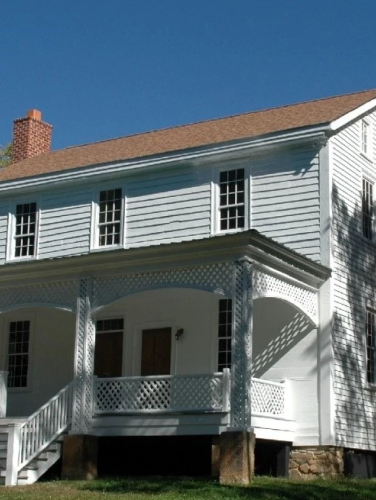
Grier-Rea House
(ca. 1815)
Prominent A.R.P. minister and cofounder of Erskine College Reverend Robert Isaac Grier raised his family in the Grier-Rea House.
6701 Providence Rd, Charlotte, NC 28270
The Grier-Rea House was the home of Reverend Robert Isaac Grier (1776-1843) and his wife Isabella Harris Grier (1783-1841). Born in Greene County, Georgia, Isaac graduated from Dickinson College in Carlisle, Pennsylvania, in 1800. Founded in 1783 on the Pennsylvania frontier, Dickinson College was initially associated closely with Presbyterianism, which likely prompted Isaac’s decision to spend two additional years in theological study under the tutelage of an Associate Reformed Presbyterian (A.R.P.) minister. Ordained in 1802, Isaac served briefly as an itinerate minister before being called to preach at the Sardis and Providence A.R.P. Churches in Mecklenburg County, and the Tirzah A.R.P. Church in what is now the Waxhaw section of Union County. He arrived in Mecklenburg County about 1804.
Property Quick Links
At that time, the A.R.P. Church was plagued by internal dissension and declining membership. Most A.R.P. congregations reunited with the Presbyterian Church in the 1820s, leaving the southern A.R.P. congregations to fend for themselves. But Isaac worked to remedy those problems. He persuaded the Sardis congregation to establish Union Academy as a training faciliy for A.R.P. ministers. During his thirty-year tenure as the pastor for both Sardis and Little Steele Creek A.R.P. Churches, he also served as a founder of both the A.R.P. Synod of the South in 1822 and Erskine College, a college and A.R.P. seminary in Due West, South Carolina, in 1839. In 1821 Isaac journeyed over 1,300 miles to visit and preach at A.R.P. congregations in Georgia, Florida, and Alabama. He traveled by horseback in 1827 to Pittsburgh, Pennsylvania in an ultimately unsuccessful attempt to reunite all A.R.P. congregations.
In 1808, Isaac married Isabella Harris of Mecklenburg County’s Steele Creek community. Soon thereafter, he purchased 102 acres on what is now Rea Road to build the extant Federal-style Grier-Rea House, located approximately midway between the two churches he served. Their son Robert Calvin Grier (1817-1871) followed in his father’s footsteps, becoming a major figure in the A.R.P. church and even serving as president of Erskine College. Isaac farmed the land using the involuntary labor of enslaved persons. The 1820 U.S. Census reports that Isaac owned seven enslaved Black persons. According to the 1840 census, that number reportedly dropped to one enslaved person, but when Isaac’s will was probated in 1843, it inexplicably bequeathed more than a dozen enslaved persons to various family members.
Following his father’s death, Robert sold the family homestead. It is unclear who acquired the house, but in 1872, Green Lee Rea (1798-1890), a prosperous Mecklenburg farmer, added the Grier farm to his substantial landholdings. His son John Laney Rea (1827-1915) and daughter-in-law Sarah Elizabeth Rea (1829-1873) made the Grier-Rea House and an accompanying 400 acres of land their home. Their son John Laney Rea, Jr. (1870-1961) acquired the house from his father in 1905, using tenant farmers to maintain agricultural operations. The youngest son of John Jr. and wife Margaret Jane Youngblood Rea (1872-1964), T. Leon Rea (1914-2000), later inherited the house, where he and wife Catherine Rea (1917-1995) lived before selling the farmland for development and the house to the Charlotte-Mecklenburg Historic Landmarks Commission for restoration and relocation approximately 1.8 miles eastward to its current location at the intersection of Providence Road and Alexander Road.

